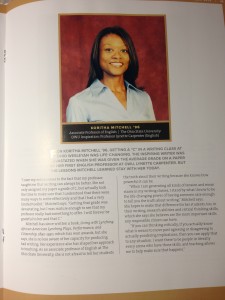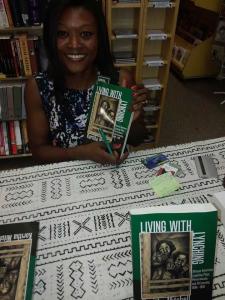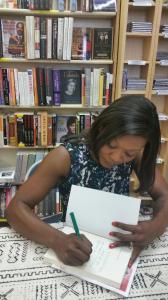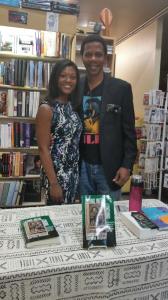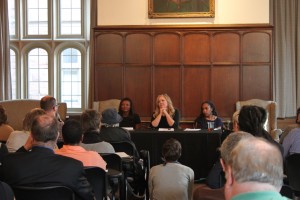In Part 4, Pablo asks what I was doing now that my book Living with Lynching was doing its work in the world. We were speaking in August 2012, so I mentioned Black LIT Radio; my essay “James Baldwin, Performance Theorist, Sings the Blues for Mister Charlie;” and my involvement in Black Girls RUN!, founded by Toni Carey and Ashley Hicks. I also shared my vision for a mentoring program that connects OSU English alumni and current students and mentioned that I’m on Twitter @ProfKori.
OSU Book Interview, Part 3
In Part 3, Pablo notes that I am a literary scholar, not a historian. He therefore asks, how did I use literary works as historical documents and convince other researchers of the validity of that methodology. Such an insightful question!
We also discuss performance as “embodied practices of belonging;” Diana Taylor‘s theory of “the archive and the repertoire;” why Crisis magazine (which is still published today) is important to Living with Lynching; and how my research influences my perspective on the present.
On this last issue—how my expertise regarding the past impacts my understanding of the present—talking with Pablo led me to make points that I think are especially important. They involve 1) recognizing that lynching was a theatrical practice and 2) my investment in critical reading practices. As I explain around 10:20 in the video, I believe I am modeling critical reading practices in my blog post “The American Way: Mediocrity, When White, Looks Like Merit.” (People continue to contact me about that piece to say that they find it useful and empowering.)
OSU Book Interview, Part 2
Our nation remains invested in sending a powerful message, that denigrating and/or destroying people of color will bring no consequences for perpetrators. (In fact, it will often bring rewards.) While we can’t help but get that message, Americans somehow see those under attack as primarily male. Besides underscoring the ongoing importance of movements like #WhyWeCantWait, this tendency reminds me of how much the suppression of Black and Brown women’s voices within my educational experiences led me to pursue the PhD.
In Part 2 of the interview, Pablo and I talk about my years in graduate school and the research interests that eventually produced Living with Lynching. These include my interest in what Black women were writing between 1870 and 1920 (the year Black men gained voting rights and the year women did); why post-Reconstruction proves to be a crucially important time period; why photography matters; why so many of the lynching plays are one-acts; and my insistence that black-authored lynching plays are not primarily protest plays.
OSU Book interview, Part 1
For at least the past 4 months, I’ve been struck by how painfully relevant my research on violence is. It’s hard to keep things straight because violence against Black and Brown people is so rampant. If we consider the past few years, even a very partial list of those killed (not just harassed or injured) by police (not civilians) becomes shocking: 7-year-old Aiyana Stanley-Jones, 12-year-old Tamir Rice, 12-year-old Santos Rodriguez, 13-year-old Andy Lopez Cruz, 14-year-old Cameron Tillman, Michael Brown, Eric Garner, Ezell Ford, John Crawford, Mateo Carlo Machella, Israel Hernandez Llach, Constantino Garcia, Carlos Mejia, Osman Hernandez, Omar Abrego, Rakia Boyd, and countless other women and trans men and women whose names we don’t know.
Especially because my book Living with Lynching centers on how people coped when they were so clearly under attack, I thought this would be a good time to revisit an in-depth conversation I had with my OSU colleague Pablo Tanguay about the book and the journey that led me to write it. The interview is in 4 parts. In this first part, we talk about my growing up in Sugar Land, Texas; my experiences as an undergraduate at Ohio Wesleyan University; and how those experiences made me interested in graduate study. Hint: Toni Morrison’s The Bluest Eye and a fabulous internship in New York City played major roles.
Especially when everything is against certain populations, it’s hard to overstate the value of reading and being willing to expose oneself (and the young people in our lives) to a variety of experiences.
Intellectual Community for Undergrads
I’ve been taking walks down Teaching & Learning Memory Lane in the last two posts, so I can’t help but also remember what the College of Arts and Sciences highlighted from a conversation with me about the possibilities for undergraduates, even at a huge place like Ohio State. Without question, it takes initiative, but undergraduates can create rich experiences for themselves if they can see their professors as something other than people who assign grades. For those who are truly paying attention to their surroundings, we represent a lot more than that.
Teaching: The Real Paycheck
Especially because the OWU magazine feature had me thinking about why I push students to improve rather than tell them what they want to hear, I was reminded of this video interview conducted by the English Department at Ohio State a couple years ago. They tracked down a student who had taken my version of the writing class that gives English majors a foundation in theoretical approaches to the study of literature. This was a pleasant surprise, largely because it does not give potential students any false impressions about my being “cool” or “understanding” or “nurturing.”
I hope you’re encouraging the young people in your life to see value in the teachers and professors who challenge them. Think about how much easier a teacher’s job is if they avoid letting the student know how their skills could be stronger—and there’s always room for growth. Yep, just think about it.
Teaching through the Pain
On Monday, November 10th, I spoke on a roundtable titled “Trigger Warnings & Tough Topics in the Classroom.” I was asked to join this discussion because I have so often articulated my approach to teaching literature that is peppered (or saturated) with the N-word. Besides conversations with my students and with colleagues around the country, I discuss this issue in “Belief and Performance, Morrison and Me,” which can be downloaded from the “Intellectual Autobiography” section of Books+Articles.
Monday’s roundtable was very much a response to national concerns regarding whether professors should provide trigger warnings when teaching controversial and/or painful material. Each speaker gave me new ways to think about the issue, but all of their stances require that instructors have exactly what American society encourages us not to have: courage.
The timing of this roundtable created an eerie effect for me. My alma mater’s magazine just published an article that captures why doing what I think will help students grow, whether it is comfortable or not, has been a hallmark of my life in the classroom. The feature made me realize just how long I have believed that growth is rarely comfortable. Because I want to equip students to make this country to live up to its creed, I guide them to grapple with the various forms of aggression that result from Americans’ investment in racism, (hetero)sexism, and classism, including racial violence, sexual violence, anti-LGBT violence, grossly unequal access to education, and overexposure to incarceration.
As the feature makes clear, the fact that writing effectively is difficult (and usually involves an ugly process) is another reality with which I want my students to grapple. The online version is here: At the Root of Great Teaching. (page 25)
Los Angeles!
What a weekend in LA! I presented “Michelle Obama, Medical Center Administrator, Plays Mom-in-Chief” to continue refining my ideas about homemaking anxiety. This presentation was for a panel titled “Can Black Women Have Fun?: Beyond Mammies and Martyrs,” with Professors Margo Crawford and LaKisha Simmons and moderated by Professor Sandy Alexandre (author of Properties of Violence). We were disappointed that Professor Deborah McDowell could not join us, but it became a lovely reunion!
Still, what made this weekend truly remarkable was the opportunity to do a book signing at Eso Won Books, a national treasure.
The people I met are certainly doing important work. Besides being introduced by James Fugate, co-owner of Eso Won, I met Dwight Trimble, the founder of BlessUp. I was also pleased to meet Torrence Brannon-Reese, CEO and Founder of FAMLI, INC, which offers comprehensive life skills management and mentoring programs, such as See a Man, Be a Man.
I met many more amazing people than I can try to list, but I will cherish this experience always! And, one of the things that made it such a success is that the Liberated Sisters radio show had me on as a guest the day before the event. Several in attendance at Eso Won said it was that conversation that got them in the door. You can listen here. (Lots of interesting context and news at the beginning of the recording. The Living with Lynching focus begins around 5:23)
Walking, Running, Supporting Girls
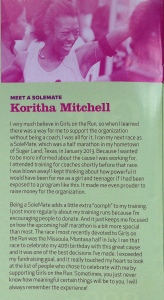
feature on my experiences as a Girls on the Run SoleMate in The Girl’s Book, 2014-15 Columbus Edition (click picture to enlarge)
I know that running improves my intellectual work, so I believe my running helps others because I always strive to do work that empowers people to be better citizens. Not surprisingly, then, I love it when my running even more directly helps others, as when I volunteer as a Girls on the Run SoleMate.
Girls on the Run is an international organization with “councils” wherever there are adults willing to support their important mission. Each council has several sites where girls can participate in the Girls on the Run curriculum, which focuses on 3rd through 8th graders. As they put it, “We inspire girls to be joyful, healthy and confident using a fun, experience-based curriculum which creatively integrates running.” You can support this crucial work by becoming a coach, by becoming a SoleMate, or by simply donating.
You can also volunteer on a one-time basis by volunteering at one of their 5K races. Each council caps off the girls’ 10-week curricular experience by sponsoring a 5K in the Fall and in the Spring. Wherever you live, consider opportunities by finding your nearest group on the main Girls on the Run website. For those in Columbus, Ohio, you can volunteer as soon as November 15th at this season’s 5K!!! For the girls’ safety, you will need to be cleared, so inquire early by visiting http://girlsontherunfranklincounty.org/5K/
Please read the feature on this page for a sense of how being a SoleMate works and feel free to contact me if you have any questions. Let’s keep walking, running, and supporting girls!
Washington University, St. Louis, Ferguson
The American Culture Studies (AMCS) program at Washington University in St. Louis has launched a dynamic project on Modern Segregation. AMCS Director Iver Bernstein and his collaborators, including professor Rebecca Wanzo, created a lecture series to fuel deeper conversations about racial realities in St. Louis and Ferguson, the United States and beyond. On Friday, October 24th, I had the honor of sharing the stage with award-winning historian Heather Ann Thompson to contribute to this important ongoing discussion.
Our contributions centered on Identity, Place, and Violence. My remarks were adapted from my Callaloo article “Love in Action” about the parallels between lynching and anti-LGBT violence. Dr. Thompson urged us to interrogate what “violence” means in the age of segregation and mass incarceration. Quite powerfully, she noted that when Americans say “violence,” we often do NOT mean the state-sanctioned violence visited on people of color. As Americans, we ignore that violence and instead pretend that communities of color are violent and would benefit from learning from whites. With research about our current historical moment as well as mounds of evidence from U.S. history, Dr. Thompson gave us much to consider as citizens who want to see our nation live up to its creed.
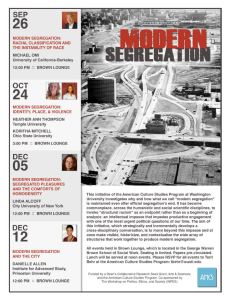 The larger Modern Segregation project will yield public engagement of various forms. The lecture series that Dr. Thompson and I enjoyed contributing to includes Michael Omi (co-author of the foundational Racial Formation in the United States: From the 1960s to the 1990s), renowned philosopher Linda Alcoff, and Princeton University political theorist Danielle Allen.
The larger Modern Segregation project will yield public engagement of various forms. The lecture series that Dr. Thompson and I enjoyed contributing to includes Michael Omi (co-author of the foundational Racial Formation in the United States: From the 1960s to the 1990s), renowned philosopher Linda Alcoff, and Princeton University political theorist Danielle Allen.
On our last night in town, Heather asked architectural history scholar Michael Allen to take us to Ferguson, the place that has captured so much of our attention and made our areas of expertise feel painfully relevant. I won’t try to capture what that time meant to me. However, several friends and colleagues have supported the protestors in Ferguson by joining them. Because I couldn’t go, I contributed to the fundraising campaign that helped sustain them while on the road and allowed them to donate additional funds to organizations in the area. I read their various accounts with interest, and I was humbled to see and feel a bit of what they described.
The more I think about what my colleagues in AMCS at Washington University are calling “Modern Segregation,” the more amazed I am by how much faith people of color continue to have in this country’s capacity for justice. We certainly prove that faith is about hoping despite the evidence you can see. Now, THAT is visionary.
- « Previous Page
- 1
- …
- 3
- 4
- 5
- 6
- Next Page »



